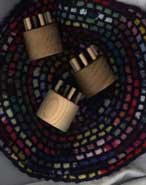
Fibres can be used without being spun first. A fabric called felt is made by rubbing together layers of wool fibres, with the aid of soap and water, which help the fibres slip together and form a close mesh. Hand-made felt doesn't really look or feel like the thin squares of coloured felt fabric you might buy to make soft toys. Traditionally, in parts of Central Asia, the nomadic people use felt over a wooden framework to make round, tent-like homes, called gers, although they are sometimes known as yurts (the yurt is actually the name given to the site in which the ger stands.) They make rugs, saddlecloths, bags and other items from the fabric, too. Warm boots and other items of clothing may be made from densely felted fabric...but felt can be very thin, delicate and lacey, too.
Why not check out feltmaking on our Bookshelf, Gallery and Links pages?
Most yarn in the high street shops is machine-spun, but you might like to try hand-spinning. If you use a drop-spindle your equipment won't cost much - in fact you can make one (see our Hints'n'Tips page) You can even gather wool from fence wire and hedges for nothing if you live near, or visit an area where sheep are farmed. (Find out more in Q & A). You can have fun using dyes to turn handspun yarn your favourite colour. (The Easy Peasy dyes are useful - see the Shop page for suppliers of spindles, spinning wheels, fibres and dyes.)
 |
Although many modern fabrics are knitted (look closely at your sweatshirt, tee-shirt and swimwear, for example) yarns can also be woven to make cloth. Usually weaving yarns are spun much thinner than hand-knitting yarns, but you can weave with almost anything - including paper, plastic bags, and sticks - as long as it's flexible. |
Weaving involves the working together of two sets of threads, a vertical one (the warp) and a horizontal one (the weft, or woof.) Usually some device is used to hold the warps tightly in position whilst the wefts are worked around them. The term 'loom' is used to describe a framework on which weaving is carried out, but looms can be anything from a simple set of parallel sticks to a huge machine and range in price from nothing at all, to many thousands of pounds/dollars, respectively.
There are lots of ways to improvise a loom, or to weave and braid without using one at all.
Some methods of textile production were used in the past but are rarely seen now. Naalbinding, sprang and lucetting are three examples of such techniques. Visit Phiala's site to find out more.
